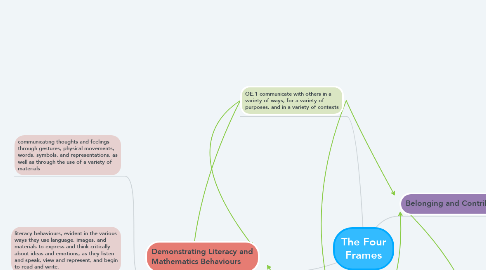
1. OE.1 communicate with others in a variety of ways, for a variety of purposes, and in a variety of contexts
2. Demonstrating Literacy and Mathematics Behaviours
2.1. communicating thoughts and feelings - through gestures, physical movements, words, symbols, and representations, as well as through the use of a variety of materials
2.2. literacy behaviours, evident in the various ways they use language, images, and materials to express and think critically about ideas and emotions, as they listen and speak, view and represent, and begin to read and write.
2.2.1. What children learn in connection with this frame develops their capacity to think critically, to understand and respect many different perspectives, and to process various kinds of information.
2.2.1.1. I try to allow for various experiences for students to see themselves as individuals who talk, listen, read, write and view media texts to allow them to understand that forms of communication will help them make sense of their world.
2.2.1.2. I try to scaffold discussions to allow for students to develop critical thinking and literacy/mathematics skills - asking questions, read alouds, naming behaviours, encouraging them to ask questions and supporting them.
2.2.1.3. I try to bring mathematics into their daily experiences and work alongside them - by asking questions, making comparisons, making observations and solving problems with them.
2.3. mathematics behaviours, evident in the various ways they use concepts of number and pattern during play and inquiry; access, manage, create, adn evaluate information; and experience an emergent understanding of mathematical relationships, concepts, skills and processes.
3. Problem-Solving and Innovating
3.1. exploring the world through natural curiosity, in ways that engage the mind, the senses, and the body
3.2. making meaning of their world by asking questions, testing theories, solving problems, and engaging in creative and analytical thinking
3.2.1. What children learn in connection with this frame is developing the habit of applying creative, analytical, and critical-thinking skills in all aspects of their lives.
3.2.1.1. I try to maintain a purposefully curious approach to new experiences rather than acting like I know how to solve the problem. "I wonder..." "How can we..."
3.2.1.2. I try to provide a flexible learning environment where students can apply their skills and improve and take risks during play
3.2.1.3. I try to emphasize the importance of perseverance and encourage students to see mistakes as learning opportunities.
3.3. the innovative ways of thinking about and doing things that naturally arise with an active curiosity, and applying those ideas in relationships with others, with materials, and with the environment
4. OE.22 communicate their thoughts and feelings, and their theories and ideas, through various art forms
5. OE. 4 demonstrate an ability to use problem-solving skills in a variety of contexts, including social contexts
6. Belonging and Contributing
6.1. their sense of connectedness to others
6.2. their relationships with others, and their contributions as part of a group, a community, and the natural world
6.2.1. What children learn in connection with this frame contributes to their attitudes that inform citizenship, connectedness to community and a positive sense of self.
6.2.1.1. I try to support students inquiries using natural materials to help extend their understanding and learning about the natural world around them.
6.2.1.2. I try to create an environment alongside the students where they are able to make decisions, collaborate and help to develop a sense of community within the classroom.
6.2.1.3. I try to use the arts to help build a sense of identity, self-esteem, sense of accomplishment and expression.
6.3. their understanding of relationships and community, and the ways in which people contribute to the world around them
7. Self-Regulation and Well-Being
7.1. their own thinking and feelings, and their recognition of and respect for differences in the thinking and feeling of others
7.2. regulating their emotions, adapting to distractions, and assessing consequences of actions in a way that enables them to engage in learning
7.2.1. What children learn in connection with this frame allows them to focus, to learn, to respect themselves and others, and to promote well-being in themselves and others.
7.2.1.1. I try to manage my own self-regulation as an invitation for the children to also self-regulate.
7.2.1.2. I try to step back and allow students to try and manage their own behaviours with the tools they have been provided with (home, school, strategies, areas in the room) to help them manage their own ability to self-regulate.
7.2.1.3. I try to use the environment as the "third teacher" providing them with materials, tools and spaces in the classroom in order for them to learn how to self-regulate.

